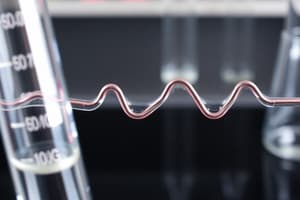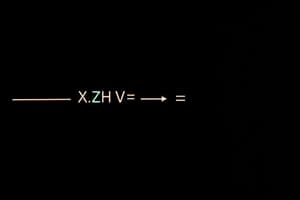Podcast
Questions and Answers
What does the Michaelis-Menten equation primarily relate?
What does the Michaelis-Menten equation primarily relate?
- Reaction velocity to substrate concentration (correct)
- Enzyme efficiency to substrate concentration
- Maximum reaction velocity to enzyme concentration
- Substrate binding to product production
Which step in the reaction scheme typically acts as the rate-determining step?
Which step in the reaction scheme typically acts as the rate-determining step?
- Substrate-product conversion (correct)
- Substrate binding
- Product unbinding
- Enzyme activation
Which of the following factors does NOT influence the rate of an enzyme-catalyzed reaction?
Which of the following factors does NOT influence the rate of an enzyme-catalyzed reaction?
- Temperature fluctuations
- Substrate availability
- Product concentration (correct)
- Enzyme identity
Which component is NOT part of the simplified reaction scheme for an enzyme-catalyzed reaction?
Which component is NOT part of the simplified reaction scheme for an enzyme-catalyzed reaction?
What denotes the Michaelis constant in the Michaelis-Menten equation?
What denotes the Michaelis constant in the Michaelis-Menten equation?
Which of the following statements about isozymes is TRUE?
Which of the following statements about isozymes is TRUE?
In an enzyme-catalyzed reaction, which step is usually assumed to occur much faster compared to the others?
In an enzyme-catalyzed reaction, which step is usually assumed to occur much faster compared to the others?
What is $V_o$ in the context of the Michaelis-Menten equation?
What is $V_o$ in the context of the Michaelis-Menten equation?
Which forward rate constant corresponds to substrate binding in the enzyme-catalyzed reaction scheme?
Which forward rate constant corresponds to substrate binding in the enzyme-catalyzed reaction scheme?
What is the assumption regarding the enzymatic reaction in Michaelis-Menten kinetics?
What is the assumption regarding the enzymatic reaction in Michaelis-Menten kinetics?
Which of the following is a key assumption of the steady state approximation?
Which of the following is a key assumption of the steady state approximation?
Which statement is true regarding enzyme kinetics under physiological conditions?
Which statement is true regarding enzyme kinetics under physiological conditions?
What is the consequence of appreciable substrate depletion during an experiment?
What is the consequence of appreciable substrate depletion during an experiment?
What does the term 'irreversibility' imply in the context of Michaelis-Menten kinetics?
What does the term 'irreversibility' imply in the context of Michaelis-Menten kinetics?
What can happen if the enzyme-substrate complex $[ES]$ levels are measured before reaching steady state?
What can happen if the enzyme-substrate complex $[ES]$ levels are measured before reaching steady state?
What is the significance of the forward rate constant $k_{cat}$?
What is the significance of the forward rate constant $k_{cat}$?
In Michaelis-Menten kinetics, what happens to product after it is formed?
In Michaelis-Menten kinetics, what happens to product after it is formed?
Which of the following enzymes would not follow Michaelis-Menten kinetics?
Which of the following enzymes would not follow Michaelis-Menten kinetics?
What must occur for the steady state approximation to hold during an experiment?
What must occur for the steady state approximation to hold during an experiment?
Flashcards
Enzyme kinetics
Enzyme kinetics
The study of how quickly enzymes catalyze reactions, focusing on the rate of substrate consumption or product production as a function of substrate and enzyme amounts.
Enzyme activity
Enzyme activity
A measure of the amount of substrate consumed or product produced per unit time.
Reaction velocity
Reaction velocity
The rate of substrate consumption or product production as a function of substrate and enzyme amounts.
Vmax
Vmax
Signup and view all the flashcards
Km
Km
Signup and view all the flashcards
Michaelis-Menten equation
Michaelis-Menten equation
Signup and view all the flashcards
Isozymes
Isozymes
Signup and view all the flashcards
Substrate binding
Substrate binding
Signup and view all the flashcards
Substrate-product conversion
Substrate-product conversion
Signup and view all the flashcards
Product unbinding
Product unbinding
Signup and view all the flashcards
Irreversibility in Michaelis-Menten kinetics
Irreversibility in Michaelis-Menten kinetics
Signup and view all the flashcards
Steady State Approximation
Steady State Approximation
Signup and view all the flashcards
Free Ligand Approximation
Free Ligand Approximation
Signup and view all the flashcards
Initial reaction velocity (Vo)
Initial reaction velocity (Vo)
Signup and view all the flashcards
Catalytic rate constant (kcat)
Catalytic rate constant (kcat)
Signup and view all the flashcards
Cooperative Enzyme Kinetics
Cooperative Enzyme Kinetics
Signup and view all the flashcards
In Vitro Enzyme Kinetics
In Vitro Enzyme Kinetics
Signup and view all the flashcards
In Vivo Enzyme Kinetics
In Vivo Enzyme Kinetics
Signup and view all the flashcards
Le Chatelier's Principle
Le Chatelier's Principle
Signup and view all the flashcards
Simplified Model of Enzyme Kinetics
Simplified Model of Enzyme Kinetics
Signup and view all the flashcards
Study Notes
Michaelis-Menten Equation
- Enzyme kinetics studies the speed of enzyme-catalyzed reactions.
- Enzyme activity measures substrate/product production per time, while kinetics examines the rate as substrate & enzyme amount change.
- The Michaelis-Menten equation links reaction velocity (V0) to maximum velocity (Vmax), Michaelis constant (Km), and substrate concentration ([S]).
- V0 = (Vmax[S])/(Km + [S])
- Reaction rates depend on substrate availability, enzyme concentration, and enzyme type. Different isozymes (same reaction, different enzymes) have different kinetic parameters.
- Figure 5.1 shows that different enzyme variants (isozymes) affect the reaction rate curves.
Assumptions of Michaelis-Menten Equation
- The model assumes an enzyme-catalyzed reaction proceeds in three steps:
- Enzyme-substrate binding
- Substrate-product conversion (usually rate-limiting)
- Enzyme-product unbinding
- Irreversibility: Product formation and unbinding are irreversible.
- Steady-state approximation: [ES] (enzyme-substrate complex) concentration remains constant throughout the experiment. This assumes initial substrate concentration is high enough to not significantly change during measurement. Initial velocity (V0) is measured, which excludes pre-steady state data.
- Free ligand approximation: Free substrate concentration ([S]) is roughly equal to initial substrate concentration. This is valid when total enzyme concentration is significantly smaller than substrate.
Additional Concepts
- Experimentally, enzymes may follow more complex mechanisms than the simplified model.
- Enzymes with cooperativity don't follow Michaelis-Menten kinetics.
- The Michaelis-Menten equation applies to in vitro (lab) measurements, not in vivo (physiological) conditions.
- Enzyme kinetics allows precise quantification of enzyme's kinetic parameters.
Studying That Suits You
Use AI to generate personalized quizzes and flashcards to suit your learning preferences.



